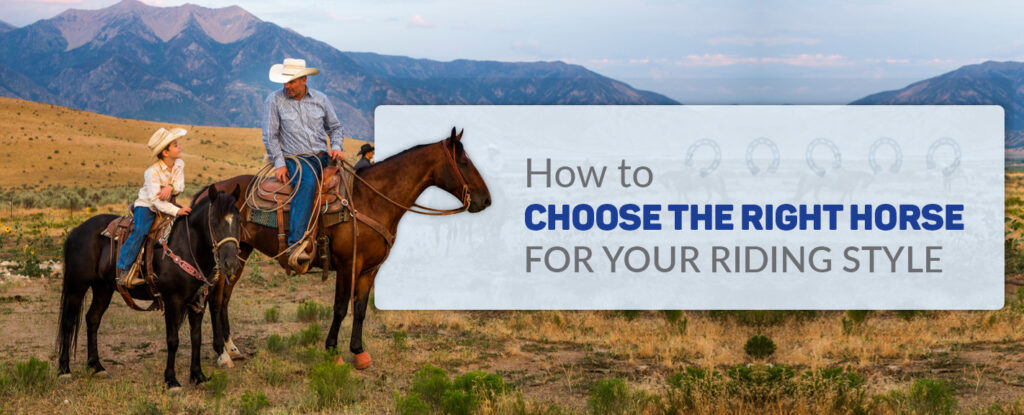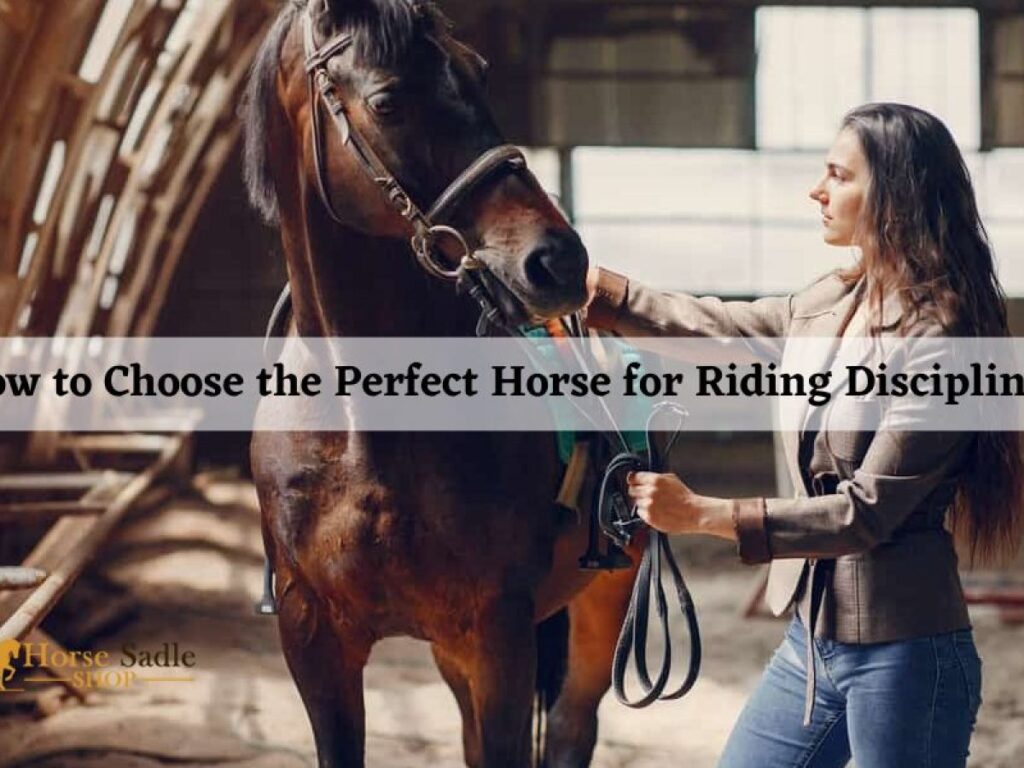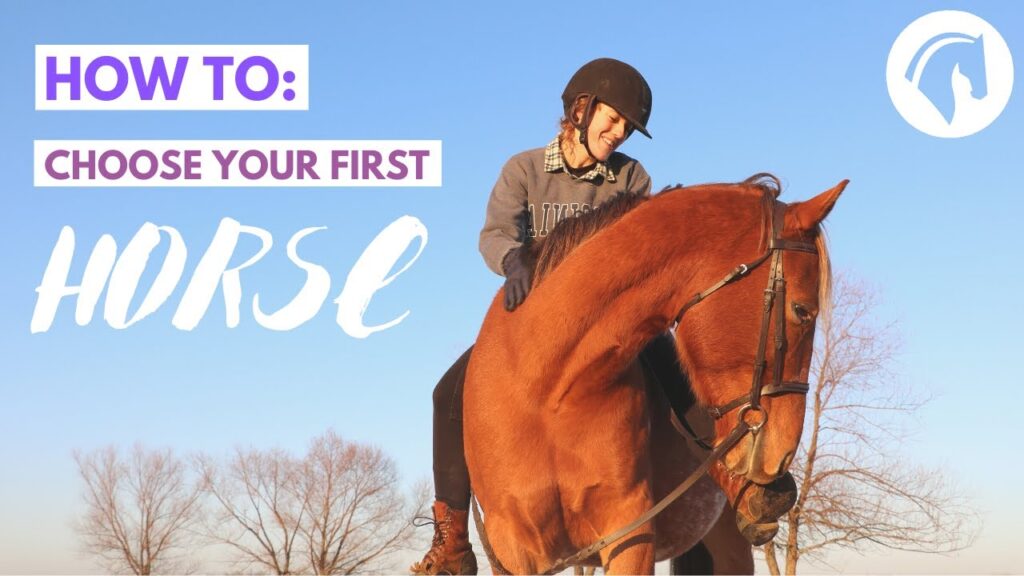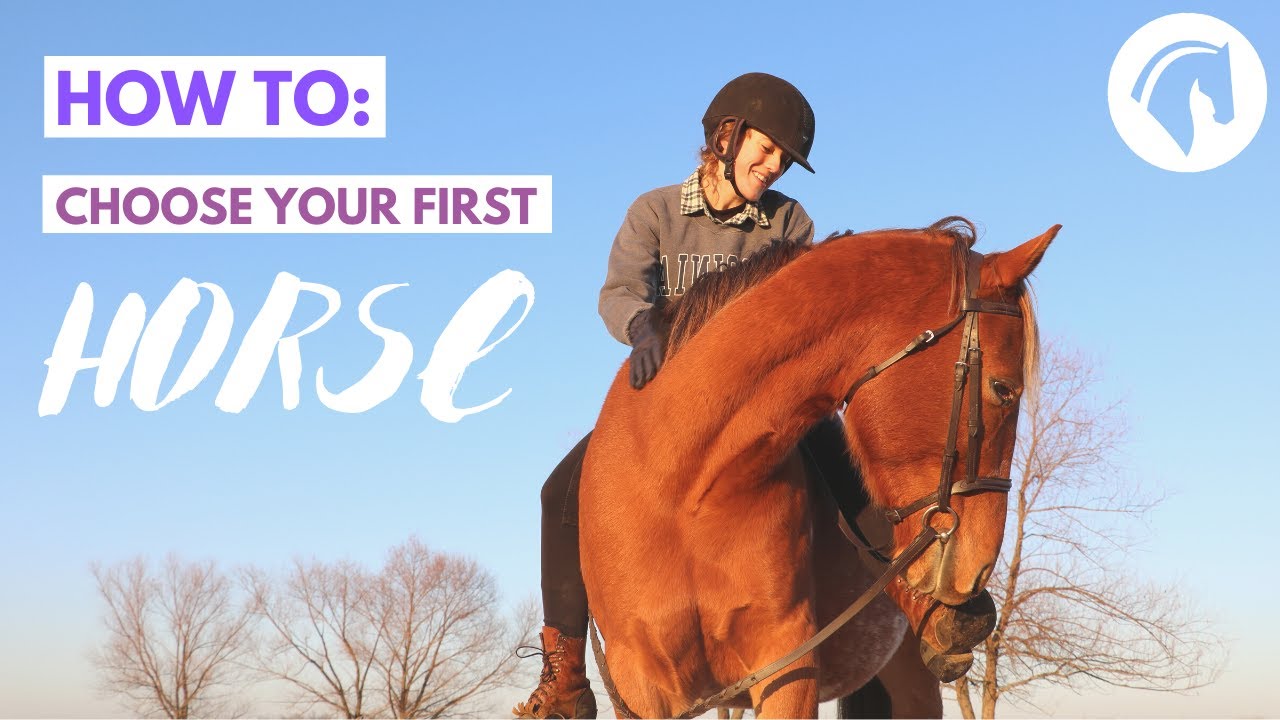Have you ever wanted to learn how to choose the perfect horse for riding? Well, you’re in luck! In this article, we’ll dive into the details of selecting the right horse for your riding needs. Whether you’re a beginner or an experienced rider, choosing the right horse is crucial for your safety and enjoyment. By the end of this article, you’ll have a better understanding of the factors to consider when selecting a horse and become a more informed rider. So, let’s get started!
When it comes to choosing a horse for riding, there are several important factors to keep in mind. Firstly, you’ll need to consider your riding experience and skill level. If you’re just starting out, it’s essential to find a horse that is calm and well-trained, as they will be more forgiving of any mistakes you may make. On the other hand, if you’re an experienced rider looking for a challenge, you may want to consider a horse with more energy and athleticism. Secondly, think about what type of riding you’ll be doing. Are you interested in trail riding, dressage, jumping, or something else? Different disciplines require different types of horses, so it’s important to choose one that is suited for your chosen activity. To learn more about these factors and discover other valuable tips for selecting a horse for riding, make sure to check out the full article on our website!
How to Choose a Horse for Riding
If you’re considering horseback riding as a hobby or sport, one of the most important decisions you’ll make is choosing the right horse. Whether you’re a beginner or an advanced rider, several factors need to be taken into account to ensure a safe and pleasurable riding experience. In this article, we’ll discuss the key factors to consider when choosing a horse, assess temperament, size, breed, health, and experience level. We’ll also explore how to match the rider with the horse, try-before-you-buy options, long-term care considerations, seeking expert advice, personal preferences, financial constraints, and legal requirements. By following these guidelines, you’ll be well-equipped to find the perfect horse for your riding journey.

Factors to Consider
Horse Temperament
The temperament of a horse plays a significant role in determining its suitability for different riders. Some horses have a calm and gentle nature, making them suitable for beginners or riders who prefer a more relaxed ride. On the other hand, high-energy horses may be better suited for experienced riders or those who enjoy a more spirited ride. Consider your own comfort level and riding goals when assessing horse temperament.
Horse Size and Age
Matching the horse’s size to the rider is essential for a comfortable and safe riding experience. Beginners or younger riders may benefit from smaller and more manageable horses, while larger riders may require horses with strong builds and larger frames. Additionally, the age of the horse should be taken into account. Younger horses might require more training and experience on behalf of the rider, while older horses may have certain limitations due to their age.
Horse Breed
Understanding different horse breeds can provide valuable insight into their characteristics and suitability for different riding styles. Pony breeds are typically smaller and are often favored by younger riders. Thoroughbreds are known for their speed and agility, making them popular choices for racing or jumping. Quarter Horses are versatile and well-suited for Western riding, while Arabians are known for their endurance and elegance. Warmbloods are often used in dressage and show jumping due to their athleticism and trainability. Researching different horse breeds will help you find a horse that aligns with your riding goals and preferences.
Horse Health
A horse’s health is crucial for its overall well-being and ability to perform under saddle. Before choosing a horse, it is essential to obtain a vet checkup report to assess any existing health conditions or potential issues. Pay special attention to the horse’s skeletal and muscular structure, digestive system health, respiratory system health, and hoof and leg health. Opting for a healthy horse will not only ensure a more enjoyable riding experience but also minimize potential risks and expenses associated with veterinary care.
Horse Experience Level
Consider your own experience level as a rider when choosing a horse. Beginner riders should look for horses with a calm temperament and previous experience with beginner riders. Intermediate riders can handle horses with more energy and may even enjoy contributing to their training. Advanced riders often seek horses that offer challenge and are capable of performing complex maneuvers. Aligning your experience level with the horse’s experience level will allow for a more harmonious relationship and enhance your growth as a rider.
Assessing Temperament
Calm and Gentle Nature
A horse with a calm and gentle nature is often a great choice for beginner riders or those seeking a relaxing riding experience. These horses are generally well-behaved, patient, and less likely to spook or become easily agitated. They are well-suited for pleasure riding, trail riding, or riders who simply prefer a slower pace.
Energy Level
The energy level of a horse refers to its enthusiasm and willingness to move or work. Horses with higher energy levels are often more spirited, requiring confident and experienced riders who can handle their energy and direct it appropriately. These horses may be better suited for competitive sports, such as jumping or racing, where a higher level of energy is advantageous.
Nervous or Skittish Behavior
Some horses may display nervous or skittish behavior, often due to previous experiences or improper handling. It is essential to carefully assess a horse’s temperament and behavior, especially if you are a beginner or lack experience in handling such horses. Nervous or skittish behavior can make riding challenging and potentially dangerous, so it’s crucial to choose a horse that matches your comfort level and skill set.
Response to Training
A horse’s response to training is an important consideration when choosing a riding horse. Some horses are naturally more receptive to training and are quick to learn new cues or commands. Others may require more time and patience to adapt to new skills or exercises. If you have specific training goals in mind, it is essential to choose a horse that is responsive to training and can effectively communicate with you as a rider.

Choosing the Right Size and Age
Matching Horse Size to Rider
Matching the size of the horse to the rider is crucial for a comfortable and safe riding experience. Smaller riders or beginners may find it easier to handle horses of smaller stature, as they are generally less intimidating and more manageable. Larger riders, on the other hand, may require the support and strength of a larger, stronger horse. Consider the dimensions of the horse, including height, weight, and build, to ensure a proper fit for both rider and horse.
Considering Age for Skill Level
The age of the horse should also be taken into account when choosing a riding companion. Younger horses often require more training and experience from the rider, as they may still be developing physically and mentally. Older horses, while potentially more experienced and reliable, may have certain limitations or health issues due to their age. Assess your skill level and goals as a rider to determine the ideal age range for your chosen horse.
Horse’s Physical Ability
Assessing a horse’s physical ability is essential to determine its suitability for the type of riding you intend to pursue. Different riding styles, such as dressage, jumping, or trail riding, place varying demands on a horse’s body. Ensure that the horse you choose possesses the necessary physical attributes and abilities to excel in your desired riding discipline. A vet checkup report, as mentioned earlier, can offer valuable insights into a horse’s physical condition and abilities.
Understanding Different Horse Breeds
Pony Breeds
Ponies are often a popular choice for younger riders or those who prefer smaller-sized horses. Pony breeds, such as Shetland Ponies or Welsh Ponies, are known for their hardiness, gentle nature, and versatility. They are often suitable for various riding disciplines, such as pleasure riding or competing in pony classes. Ponies can provide an excellent foundation for young riders and introduce them to the joys of horseback riding.
Thoroughbred
Thoroughbreds are best known for their speed and agility. They are commonly used in racing but can also excel in other disciplines such as show jumping or eventing. Thoroughbreds are intelligent and trainable, but their high energy levels may require an experienced rider to properly manage and direct their enthusiasm. Their athleticism and competitive nature make them a thrilling choice for riders seeking a challenging and fast-paced riding experience.
Quarter Horse
The Quarter Horse is a versatile breed renowned for its strength, athleticism, and docile temperament. Originally bred for work on ranches, these horses excel in Western riding disciplines such as reining, cutting, and barrel racing. Their calm and willing nature makes them suitable for riders of all skill levels, from beginners to advanced riders. Quarter Horses are not only highly trainable but also known for their natural cow sense, making them ideal for cattle work as well.
Arabian
Arabian horses are known for their distinctive beauty, endurance, and strong bond with their riders. These elegant horses often excel in endurance riding and are also well-suited for various disciplines, including dressage and show competitions. Arabians are known for their intelligence, sensitivity, and willingness to please their riders. Their expressive nature and graceful movements make them a popular choice for riders seeking a combination of aesthetics and performance.
Warmblood
Warmbloods are a group of sport horse breeds that combine the best qualities of other breeds, such as athleticism, elegance, and trainability. They are commonly used in dressage, show jumping, and eventing due to their exceptional movement and willingness to work. Warmbloods often possess a calm and reliable temperament, making them suitable for riders of different skill levels. These horses are the result of careful breeding programs that aim to produce versatile and high-performing athletes.

Assessing Horse Health
Vet Checkup Report
Before finalizing your decision to purchase or lease a horse, it is crucial to obtain a vet checkup report. This report provides essential information about the horse’s overall health, potential underlying issues, and any necessary treatments. A qualified veterinarian assesses various aspects, including the horse’s musculoskeletal system, digestive system, respiratory system, and hoof and leg health. This thorough evaluation ensures that you choose a healthy and capable horse, minimizing potential health issues and expenses in the future.
Skeletal and Muscular Structure
A horse’s skeletal and muscular structure significantly influences its soundness and ability to carry a rider comfortably. It is vital to assess these aspects, particularly if you have specific riding goals or disciplines in mind. Look for a horse with well-developed muscles, balanced conformation, and no visible lameness or physical abnormalities. A strong and structurally sound horse will have a higher capacity to perform and stay sound throughout its riding career.
Digestive System Health
The health of a horse’s digestive system can impact its overall well-being and performance. Proper digestion ensures efficient nutrient absorption, which directly affects a horse’s energy, stamina, and overall health. Pay attention to the horse’s eating habits, weight, and fecal consistency to assess the health of its digestive system. Consulting with a veterinarian and implementing a proper diet plan will ensure that the horse’s digestive system remains healthy and functional.
Respiratory System Health
A healthy respiratory system is essential for a horse’s ability to perform athletically and comfortably. Examine the horse for any signs of respiratory distress, such as coughing, wheezing, or labored breathing. These symptoms may indicate underlying respiratory conditions, which can significantly impact the horse’s stamina and long-term riding potential. Lung function tests or X-rays can provide further insights into the health of the respiratory system.
Hoof and Leg Health
The soundness of a horse’s hooves and legs is crucial for its ability to carry the weight of a rider, withstand impact, and move comfortably. Inspect the hooves for any signs of lameness, hoof deformities, or defects. The horse’s legs should appear sturdy, without swelling, heat, or pain. Hoof and leg health are crucial indicators of a horse’s overall soundness and ability to perform under saddle. Regular hoof care, such as trimming and shoeing, helps maintain the horse’s hoof health and promote sound movement.
Consider Rider’s Experience Level
Beginner Riders
For beginners, it is crucial to choose a horse with a calm and gentle demeanor, as well as previous experience working with novice riders. These horses should be well-schooled, patient, and forgiving, allowing beginners to learn and become comfortable in the saddle. Working with a seasoned riding instructor can help match beginners with horses suitable for their skill level and build a solid foundation in horsemanship.
Intermediate Riders
Intermediate riders have developed a basic skill set and are comfortable in the saddle. They can handle horses with more energy and may be interested in honing their riding abilities or exploring specific disciplines. Intermediate riders may benefit from horses that can challenge them, allowing for further growth and progression. Consider horses with specific skills or training in your desired discipline to enhance your riding experience and advance your abilities.
Advanced Riders
Advanced riders possess a high level of skill and experience in different riding disciplines. They often seek horses that offer challenge, advanced maneuverability, and competitive abilities. Advanced riders may be interested in horses with specific training, such as dressage movements or jumping techniques. These riders can handle spirited horses with higher energy levels, allowing for exploration of more demanding riding techniques and goals.

Matching Rider with Horse
Compatibility in Riding Style
Matching the rider’s preferred riding style with the horse’s abilities and training is crucial for a harmonious partnership. Consider what type of riding style you enjoy or aspire to pursue, whether it’s Western, English, dressage, jumping, or trail riding. Each riding style demands different skills, movements, and techniques from both rider and horse. Ensuring compatibility in riding style enhances the riding experience and promotes growth and success for both.
Matching Rider Goals with Horse Abilities
Clearly defining your riding goals helps in finding a horse that aligns with your ambitions and aspirations. Whether you aim to compete in shows, progress in a specific discipline, or simply enjoy recreational riding, finding a horse with the abilities and potential to meet your goals is essential. Communicate your goals to riding instructors or equine professionals who can provide guidance and help you find a horse capable of supporting your aspirations.
Understanding Rider’s Physical Limitations
It is essential to consider any physical limitations or challenges you may have as a rider. Physical factors, such as height, weight, or physical disabilities, may influence your choice of horse. Certain riding disciplines may require specific physical attributes or capabilities. By acknowledging your physical limitations, you can find a horse that complements your abilities and ensures a safe and enjoyable riding experience.
Try-Before-You-Buy
Leasing a Horse
Leasing a horse allows riders to experience horse ownership without the full financial commitment. Leasing arrangements can vary, with options for full or partial leases, short or long-term leases, and different levels of responsibility. This arrangement enables riders to develop a relationship with a specific horse, assess compatibility, and gain confidence before making a more permanent commitment. Leasing can be an excellent option for riders who are unsure about long-term ownership or want to explore different horse personalities and abilities.
Lesson Riding
Participating in riding lessons provides invaluable opportunities to ride different horses and assess their suitability. Riding instructors often have a variety of lesson horses to accommodate riders of different skill levels and goals. Regular lesson riding allows you to develop your riding abilities, gain experience with different horses, and identify the characteristics or traits you prefer in a riding companion. Riding lessons also provide continuous feedback and guidance from experienced instructors who can help you make informed choices when selecting a horse.
Taking a Trial Ride
Taking a trial ride allows you to experience firsthand how a horse behaves and performs under saddle. Requesting a ride on the horse you are considering purchasing or leasing allows you to assess their temperament, responsiveness to cues, and overall suitability. It is advisable to conduct a trial ride in an environment similar to where you plan to ride regularly, such as an arena or trail. Partner with an experienced rider or instructor during the trial ride to ensure your safety and to gain additional insights and feedback.

Long-Term Care Considerations
Stabling Availability
Before bringing a horse home, it is essential to have suitable stabling arrangements in place. Whether you plan to keep the horse on your property or board it at a stable, ensure that the facilities meet the necessary standards for housing and care. Consider factors such as stall size, turnout area, quality of the fencing, availability of shelter, and proximity to quality hay, feed, and water sources. Providing a comfortable and safe living environment is crucial for the long-term well-being of your horse.
Feeding and Nutrition
Proper feeding and nutrition are essential for maintaining a horse’s health and performance. Horses have specific dietary requirements, including a balanced diet of hay or pasture, quality grain or concentrates, and necessary vitamins and minerals. Consult with an equine nutritionist or veterinarian to develop a feeding program tailored to your horse’s needs, taking into consideration age, activity level, breed, and any existing health conditions. Regular access to fresh water is also vital for a healthy and hydrated horse.
Grooming and Maintenance
Grooming plays a significant role in maintaining a horse’s overall health and well-being. Regular grooming sessions not only keep the horse’s coat clean and free from debris but also provide an opportunity to bond with the horse and inspect for any injuries or abnormalities. Grooming also includes routine hoof care, such as picking out hooves and regular trimming or shoeing. Maintaining a grooming and maintenance routine ensures that your horse remains comfortable, healthy, and ready for riding.
Exercise and Training Requirements
Different horses have varying exercise and training requirements based on their breed, age, and discipline. Some horses require daily exercise and training sessions to maintain their mental and physical well-being. Others may need regular turnout in a pasture or access to an arena for self-exercise. Consider your own availability and commitment to providing sufficient exercise and training for your horse. This commitment ensures that your horse remains fit, happy, and cooperative under saddle.
Cost of Ownership
Owning a horse comes with significant financial responsibilities. It is essential to carefully consider the cost of ownership and ensure it fits within your budget. Regular expenses include boarding or stabling fees, feed, hay, veterinary care, farrier services, and equipment such as saddles, bridles, and grooming supplies. Additionally, unexpected expenses, such as emergency veterinary care or repairs, should be factored into your budget. Carefully assess your financial situation and determine whether owning a horse is feasible and sustainable for you.
Seeking Expert Advice
Consulting with Riding Instructors
Riding instructors are valuable resources when it comes to choosing a horse for riding. They possess in-depth knowledge and experience in matching riders with suitable horses based on their goals, abilities, and experience level. Consult with your riding instructor and provide them with a clear understanding of what you are looking for in a horse. Their expertise and familiarity with different horses can help narrow down your choices and ensure a successful pairing.
Getting Help from Equine Professionals
Equine professionals, such as trainers, breeders, or equine consultants, can provide additional guidance and expertise when choosing a horse. These professionals have extensive experience working with horses and can assess their temperament, soundness, and abilities. They can also provide insights into specific horse breeds, bloodlines, or training methods. Building a network of equine professionals can provide ongoing support and guidance throughout your journey as a rider.
Attending Horse Shows and Competitions
Attending horse shows and competitions provides an excellent opportunity to observe different horses in action. Spectating various classes or disciplines can give you a better understanding of specific breeds, riding styles, and skill levels. You can witness horses and riders of different abilities, observe their strengths and weaknesses, and even approach riders or trainers for advice or recommendations. Horse shows and competitions offer an immersive experience that can further inform your decision-making process.
Considering Personal Preferences
Horse Color
Personal preferences in horse color can play a role in your decision-making process. Horses come in various colors, including black, chestnut, bay, gray, and palomino, among others. While color should not be the sole determining factor, it can contribute to the overall aesthetic appeal of the horse and your enjoyment as a rider. Keep in mind that the horse’s temperament, health, and abilities should always take precedence over color preferences.
Horse Gender
The horse’s gender is another aspect that may be considered when choosing a riding horse. Personal preferences or riding goals may influence whether you prefer a mare, gelding, or stallion. Mares are often known for their strong bonds with their riders, while geldings tend to be more laid-back and easier to handle. Stallions require experienced and knowledgeable owners due to their hormonal behaviors and potential aggressiveness. Consider your riding goals, your ability to handle certain behaviors, and your preferred dynamic when choosing the horse’s gender.
Dealing with Financial Constraints
Determining Budget Limits
Financial constraints are an important consideration when choosing a horse. Owning and maintaining a horse can be a significant financial commitment, so it is essential to determine your budget limits. Consider the initial purchase or lease cost, ongoing expenses such as feed, stabling, and veterinary care, and the availability of financial resources to cover unexpected emergencies. Be realistic about your budget limits to ensure that horse ownership remains financially feasible and sustainable.
Exploring Affordable Horse Options
If budget constraints are a concern, explore affordable horse options that fit within your financial limitations. There are various ways to find affordable horses, such as considering older horses with valuable experience, looking for off-breed or mixed-breed horses, or exploring rescue organizations or horse adoption facilities. While affordability is important, always prioritize the horse’s health, temperament, and training to ensure a suitable match for your riding goals.
Checking Legal Requirements
Licensing and Permits
Before acquiring a horse, be aware of any licensing or permit requirements specific to your area. Different regions may have specific regulations or requirements for owning horses, including licenses for horse owners or permits for stabling facilities. Familiarize yourself with these requirements and ensure that you comply with all legal obligations to avoid any penalties or fines.
Insurance Coverage
Insurance coverage is an important consideration, providing financial protection in the event of unexpected accidents or injuries involving the horse. When owning or leasing a horse, it is advisable to explore equine insurance options that cover potential liabilities, veterinary expenses, or loss of use due to injury. Consult with an equine insurance provider to determine the appropriate coverage based on your specific needs and circumstances.
Conclusion
Choosing the right horse for riding is a significant decision that requires careful consideration of various factors. Assessing horse temperament, size, breed, health, and experience level is crucial for finding a suitable riding companion. Matching the rider with the horse, exploring try-before-you-buy options, considering long-term care requirements, and seeking expert advice contribute to a successful and enjoyable riding experience. By following these guidelines, you can find the perfect horse that aligns with your riding goals, abilities, and preferences. Remember, owning a horse is a commitment that requires time, resources, and ongoing care. With the right horse by your side, you can embark on a journey of safe, fulfilling, and pleasurable horseback riding experiences.
As you embark on your horseback riding journey, be sure to visit our website, Horseback Riding Dude, for more information and resources on all aspects of horseback riding. From riding tips and training techniques to horse health care and equipment reviews, we’ve got you covered. Happy riding!
